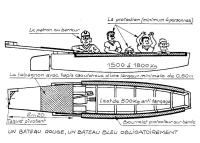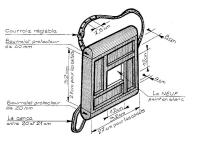|
No one is quite sure why there are two different jousting methods. It’s not even clear whether the Givordine or Lyonnaise method came first. Some claim that the second method was created by a group jousters who were unable to win championships in the traditional way. The new way allowed them to compete separately and win.

Actually, only the side passing distinguishes between lyonnaise and givordine methods, the position of the jouster being the same.
In Lyonnaise method, boats pass on the left side. 
In the Givordine method, boats pass on the right side. 
 These two methods are river's ones, and have been practiced in Rhône-Alpes region, where they come from, on the Loire river, and in Paris region since the beginning of the 20th century (see the historic chapter about the FFJSN). These two methods are river's ones, and have been practiced in Rhône-Alpes region, where they come from, on the Loire river, and in Paris region since the beginning of the 20th century (see the historic chapter about the FFJSN).
We can though notice that there are some exceptions, as La Boisse-Penchot, in Aveyron, where the givordine method has been brought by the inhabitants of Rive-de-Gier, who came to work in the glass-making factory at the beginning of the 20th century.
 The jouster, placed on a wood platform just above the water, fixed at the rear of the boat, the tabagnon, stand in a position as close as possible to the left splits, right leg at the rear, right foot wedged to the stop, left leg at the front. The jouster, placed on a wood platform just above the water, fixed at the rear of the boat, the tabagnon, stand in a position as close as possible to the left splits, right leg at the rear, right foot wedged to the stop, left leg at the front.
That position leads to two poses depending on the position of the left leg :
- one called broken leg : the thigh is in extension, the lap slightly bent.
- the other called taut leg : the leg is in the extension of the thigh.
That last manner is much closer to the splits.
That position, typical of lyonnaise and givordine methods, is spectacular but, needing strength and suppleness, requires a long training.
The lance, the heaviest and longest of all joust methods, is hold with both hands.
One of its extremities is placed inside the right hand palm, the hand being pinned to the right thigh, and held in position by the bourron, The lance is also held by the left hand, all fingers of it except the thumb passing through the braid of the plastron, the hand being applied on the left lap.
 The jouster wears a plastron, the center of which the opponent has to put up the metallic extremity of its lance. One says piquer dans le neuf, which can be translated by \rput up the nined. Despite of its name, the plastron is not worn on the breast, but on the front of the shoulder, and the left arm. The jouster wears a plastron, the center of which the opponent has to put up the metallic extremity of its lance. One says piquer dans le neuf, which can be translated by \rput up the nined. Despite of its name, the plastron is not worn on the breast, but on the front of the shoulder, and the left arm.
  The jouster must be in joust position when the boats pass, that means spear down, the plastron well presented to the adversary (that is to say enough face to him so that it is easily visible). During the whole push, he must have only its two feet in contact with the tabagnon. If a lap, a calf, a hand, or the bourron comes to touch the tabagnon, he will be declared as wet, because of avoir briqué. An expression which comes from the wooden navy, where, to clean the bridge, the sailors put to knees and brushed the bridge with a brick, which was said briquer. The jouster must be in joust position when the boats pass, that means spear down, the plastron well presented to the adversary (that is to say enough face to him so that it is easily visible). During the whole push, he must have only its two feet in contact with the tabagnon. If a lap, a calf, a hand, or the bourron comes to touch the tabagnon, he will be declared as wet, because of avoir briqué. An expression which comes from the wooden navy, where, to clean the bridge, the sailors put to knees and brushed the bridge with a brick, which was said briquer.

Games are done by age and weight categories, in three passes, as well for the qualification than for the final. The jouster, who commits a fault or put to the water by its opponent, is declared wet.
In each of givordine and lyonnaise methods, there are two kinds of tournaments.
The in force joust, which as its name says, consists in being the stronger and pushing its opponent to the water, respecting the rules.
The joust called en belle passe, litteraly in beautiful pass, which means with style and tradition, is a presentation of joust, but the appreciation, therefore the points, takes into account the presentation and the way the jouster is dressed, the technical quality of the pass, the body position, the pulling down and the holding of the spear, and the accuracy of the touch. That kind of joust respects as well the general regulation of the jousts.

 Haut Haut
|